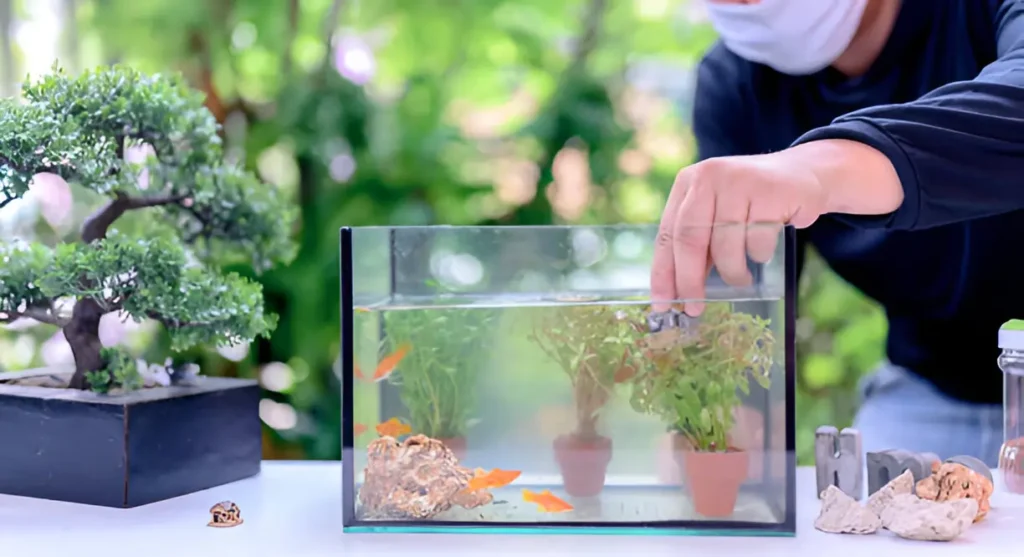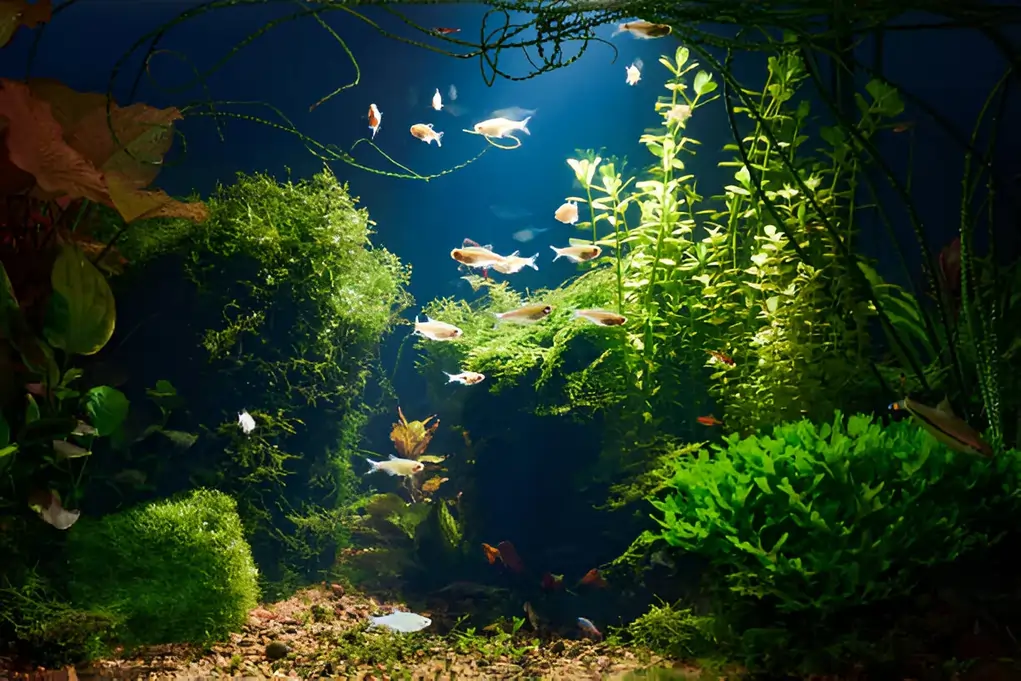Setting up a fish tank is an exciting and rewarding hobby. However, beginners often overlook essential steps that can make or break a successful aquarium environment. A carefully prepared fish tank not only looks beautiful but ensures the health and happiness of your fish.
Choosing the Right Fish Tank
Getting the right tank is the first step to keeping your aquarium healthy. Space, tank shape, and location are all things to think about when making a setting that is stable, safe, and nice to look.
Best Fish Tank Setup for Beginners
A 10 to 20 gallon fish tank is usually good for people who are just starting out. These sizes are manageable and give you enough space to add a small community of fish without having to do a lot of care. Beginners usually do better with rectangular tanks because they give fish more room to swim and are easy to set up on stable stands.
Choosing the Right Fish Tank Size and Location
Size and location of the tank have a big effect on the health of the fish. If you need to connect important equipment, choose a spot that is out of direct sunlight and close to a stable power source. For example, don’t put the tank in a place where the temperature changes a lot. You can move on to tools once you’ve picked out the right size and spot.
Essential Equipment Checklist
A well-set up fish tank needs certain things to keep the water clean, the lights on, and the temperature stable. This makes a healthy environment for your fish.
Heating and Lighting Requirements
For fish and plants to live, they need light and warmth. For tropical fish, keeping the tank at a temperature between 75°F and 80°F is important. Pick lights that are right for your tank. For instance, full-spectrum LED lights that work like sunshine help plants that grow in freshwater with photosynthesis.
Filtration Options and Why They Matter
You can’t do without a filter that works well in your setting. Filters clean water by getting rid of dirt and other impurities, keeping chemicals in balance, and adding air. You can pick from undergravel filters, external filters, and internal filters. Internal filters are good for smaller tanks, and external filters are great for bigger tanks. An activated carbon filter is famous because it gets rid of impurities and smells.
Air Pumps and Other Necessary Equipment
Oxygenating the water is very important for fish health, and air pumps help do that. Air pumps aren’t necessary in all tanks, but they’re helpful in setups with a lot of fish or fish that like water with a lot of oxygen. Also, buy water testing kits so you can keep an eye on the amounts of pH, ammonia, and nitrate on a regular basis.
Preparing and Adding Substrate
Substrate is the stuff that covers the tank bottom. It gives it a natural look and can support plant roots, help good bugs grow, and make a good place for fish to live at the bottom.
Types of Substrate: Gravel, Sand, and More
Most rainwater tanks use gravel or sand as their base. Gravel is easy to clean and good for many types of fish. Sand, on the other hand, looks natural and is great for fish that eat at the bottom. For planted tanks, aquatic soil is a choice because it has nutrients that plants need to grow.
How to Prepare Substrate for Fish Tank
Remove all dust and other unwanted bits from the substrate before adding it. It will be cleaner if you rinse it under cold water until it runs clear. Then, put down a smooth layer on the bottom of the tank that is about 1 to 2 inches thick. This will help plants and decorations stay in place.
Filling and Dechlorinating the Water
Water clarity is very important for aquarium plants to grow. Knowing how to prepare water for your fish tank will keep your fish safe and healthy.
How to Fill a Fish Tank for the First Time
Slowly add water to your tank to avoid disturbing the ground as you fill it up. By blocking the flow of water, a plate or bowl at the bottom keeps the water from becoming cloudy. To keep splashes from happening and make room for tools on the tank walls, fill the tank up to an inch from the top.
Importance of Water Dechlorination
Most tap water has chlorine in it, which is bad for fish. Chlorine changes the way gills work, which can make fish have breathing problems or even kill them.
Dechlorinating Methods and Tips
Dechlorinators and water conditioners are what you need to get rid of chlorine. Carefully follow the dosage guidelines and make sure the water has a lot of air in it, especially if you’re using city water. Some aquarists say that you should let tap water sit overnight before putting it in the tank, but filters work faster and better.
Understanding the Nitrogen Cycle
The nitrogen cycle changes chemicals that are bad for you into forms that are not as bad. This makes the world safe for your fish. Cycling your tank before adding fish keeps it from becoming harmful and improves the health of the fish.
What is the Nitrogen Cycle?
To put it simply, fish waste makes ammonia. Good bacteria then break this down into nitrites and then nitrates. Fish can get sick from both ammonia and nitrites, but nitrates are safer in small amounts. Cycling your tank builds up these colonies of bacteria, which makes the tank livable.
Fishless Cycling vs. Adding Fish Early
Beginners should do riding without fish because they don’t have to worry about harmful ammonia spikes. To cycle the tank without fish, add a little ammonia or fish food. After a few weeks, good bacteria will start to grow, which will make the water stable. Keep an eye on the levels with testing kits, and don’t add fish until the ammonia and nitrite levels are zero.
Monitoring and Adjusting for Safe Levels
During the cycling process, test your water often and make changes to the settings as needed. It should not be possible to find ammonia, and the amount of nitrate should stay below 20 ppm. Do a partial water change to bring the amounts down if they are too high.
Decorating the Tank
Decorations make your tank look unique and give your fish a place to hide and play. Be careful when picking decorations because some materials can change the chemistry of water or be dangerous.
Choosing Safe Decorations
Choose accessories made from non-toxic materials that are safe for aquariums. People like to use rocks, plants, and logs, but if you get them outside, you should wash and germ-proof them well. Stay away from rough or sharp objects that could hurt fish.
Tips for Plants, Rocks, and Other Decor
Adding live plants makes the setup look nice, helps with natural filtering, and keeps the water quality stable. Make sure plants get enough light by anchoring them in the ground. To make fish feel safe, use smooth rocks and make small holes for them to hide.
Introducing Fish to the Tank Safely
It takes time and care to move fish to a new tank. Suddenly changing the water conditions can be scary or stressful for fish, so they need to get used to them slowly.
Acclimating Fish to New Tank Water
Float the bag in the tank for 15 to 20 minutes to get the temperature right before adding the fish. Every 5 to 10 minutes, add a little tank water to the bag and mix it in slowly. This will help the fish get used to the pH and hardness. This process lowers stress, which is important for health in the long run.
How to Introduce Different Fish Types
Some fish are protective or sensitive to changes in the water. When adding more than one type, find out if they get along with each other. Also, don’t add too many fish at once, as this can mess up the nitrogen cycle. Begin with hardy fish like guppies or danios, and as the tank gets more stable, add fish that are more easily hurt.
Ongoing Maintenance and Common Pitfalls
Maintenance checks keep the tank clean and stop health problems before they happen. You can avoid making a lot of the mistakes that new fish keepers make if you take good care of your fish every day.
Weekly Maintenance Routine
A 10–20% water change once a week helps keep nitrate levels in check. To clean up the ground, use a gravel vacuum. Use an algae scraper to get rid of algae on the tank walls, and check the filter parts for buildup or clogs.
Troubleshooting Common Issues
Beginners often have to deal with dirty water, algae blooms, and sick fish. Bacterial blooms can cause cloudy water, but they usually go away in a few days. Blooms of algae mean that there are too many chemicals or too much light. To fix these problems, change the lighting and keep an eye on the food.
Special Fish Tank Setups
As each type of fish has different needs, setting up the tank so it’s perfect for that type of fish, like goldfish or exotic fish, is important.
Setting Up a Tropical Fish Tank
Tropical fish tanks usually need heaters to keep the water warm. Because they look like natural environments, real plants are also good for some tropical fish. Keep an eye on the pH and hardness of the water to see what each species needs.
Setting Up a Goldfish Tank
Goldfish need a bigger tank with strong filtering because they make more waste than most other fish. Since they do better in cooler water than tropical fish, fans are usually not needed. Goldfish need a lot of space to swim, so keep their tanks big and not too fancy.
Conclusion
Setting up a fish tank for the first time can be an enjoyable and fulfilling experience. By carefully following these preparation steps, choosing the right equipment, and maintaining a balanced ecosystem, you’ll create a beautiful and healthy environment for your fish. Happy fishkeeping!


